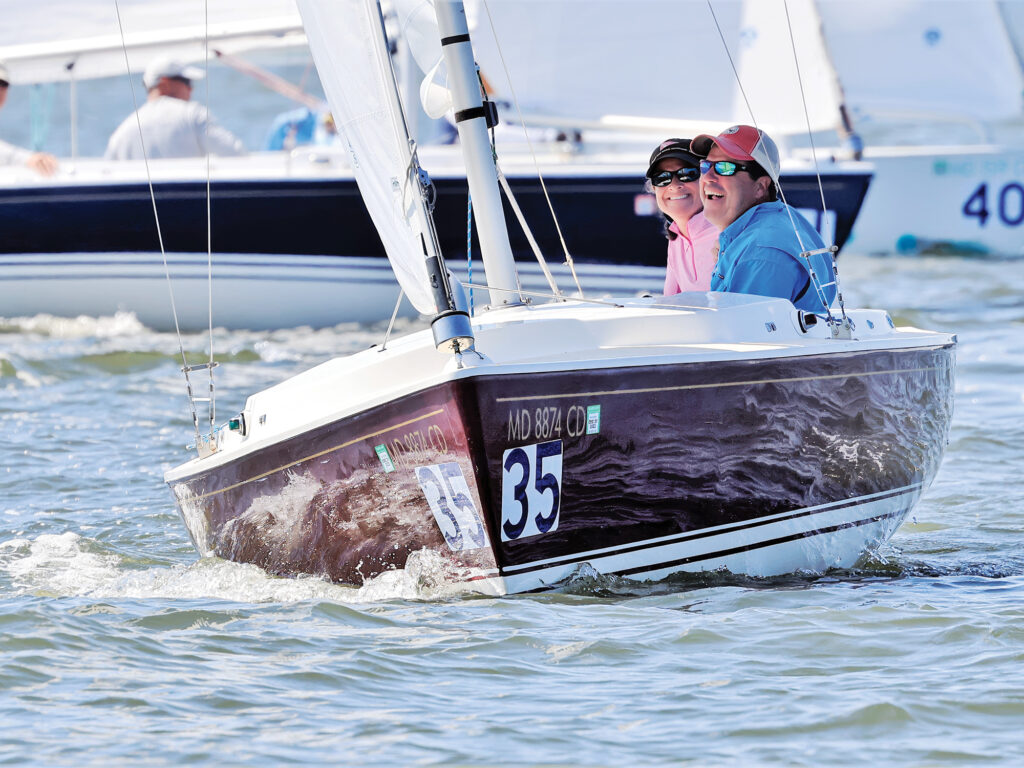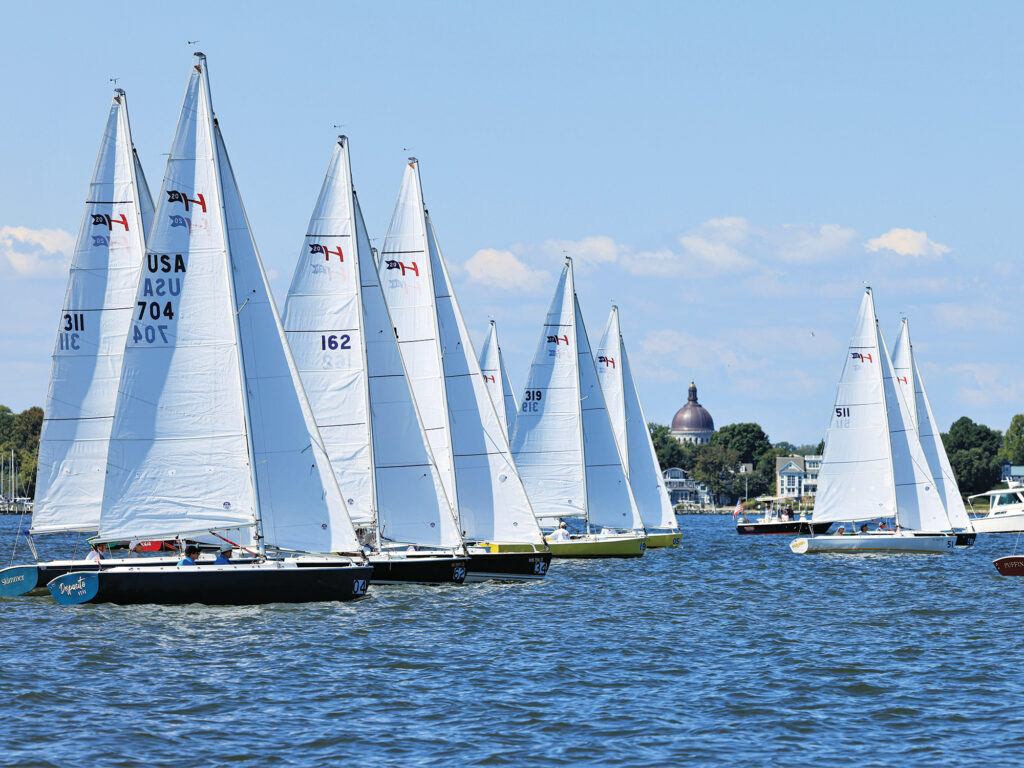
during a walk along the Annapolis shoreline a few years ago, I noticed a fleet of boats racing on the harbor. From a distance, it looked well-organized and plenty competitive. And as I watched them go around the usual channel buoys that they were using as race marks in an orderly fashion, I wondered who it was who had been responsible for getting this fleet started from scratch. We all know that it can be difficult to run a local racing fleet, never mind to start one, but we also know that behind every successful fleet, there’s usually a spark plug or two, the heroes of our local fleets, and as expected, the fleet that I observed that day on my shoreline stroll has theirs.
As one of the more successful and newer fleets to take hold in Annapolis, the Harbor 20s sailors make up the tightknit community of Fleet 5. Initially, there were a handful of Harbor 20s that raced PHRF back in 2005, but in 2011, local yacht broker Garth Hichens sold a group of sailors on the idea of creating a one-design class in Annapolis. The Harbor 20, built by WD Schock in California, is best-suited for either two or three crew, and the class has strong pockets in the US, especially venues with protected harbors for which the boat was designed. It’s meant to be a simplistic daysailer, so Hichens and the group agreed to make it a nonspinnaker class. Its self-tacking jib-boom makes things even easier on the crew.
Fleet 5’s early adopters comprised novice racers to skilled veterans, and fleet members made sure that the social aspect was a priority. The endeavor quickly encouraged more local sailors to acquire boats, and as a result, the fleet grew rapidly. But it also needed structure to ensure fairness and long-term viability, and two successive fleet captains have provided the leadership and resolve to maintain governance of the fleet, organize racing logistics, and work to improve the competitive level of the racing and to grow the fleet.
Enter Annapolitan Bell Carty, who comes from a racing family and was named fleet captain just as the COVID-19 pandemic was sweeping across the country. She says that it took quite a bit of work to get the fleet organized. “I inherited a fleet that was thriving, but there was little structure,” Carty says. “We had a lawsuit to deal with, and we needed insurance and a better way to communicate.”
Retired attorney John Heintz, who was one of the early Harbor 20 owners in Annapolis, stepped forward to help resolve the lawsuit with the builder in California, and he worked on an insurance policy for the class and the sailors themselves. “After the dispute was eventually resolved, we incorporated our local fleet and secured appropriate insurance for both the class and the fleet for the first time.”
Then came the communication challenges, which Carty says was a result of too many means of outreach to fleet members. “We created a website and pushed all our messaging through the site,” she says. “If something happens, it’s important to keep in touch to reduce any tensions that might arise. We make sure to communicate with everyone, not just the fast sailors, so no one is left out. We also make sure that everything we are running is fun.”
Heintz is keen on the fleet’s regularly scheduled Thursday coffee-and-breakfast gatherings at Annapolis YC, which follow each Wednesday-night race during the summer. The topics vary, and open discussions help resolve contentious issues, which, if left to fester, can create more headaches later on. “People can express their views in a thoughtful way,” Heintz says. “We are a group of friends trying to keep it that way. If necessary, we consult with people outside the class.”
Carty adds that it was important for the fleet to write a set of bylaws and determine an appropriate owner-driver fleet policy. They also designated that higher-level regattas would mandate that the boat owner be at the helm when racing. It’s also important for the fleet to vary the style of races, she says, so not all of them are windward-leeward. Sometimes they’ll simply have an informal race to someone’s house on the water.
While Heintz spent his early years practicing law, he cruised his C&C 39 for 14 years with his brother, and then his Saga 43 with his wife for 15 years, mostly transiting between the Chesapeake Bay and Maine. “I got into racing late in my career,” he says. “As the fleet grew around me, others came along to challenge me. I’ve learned from watching.”
The Harbor 20s sail very close to each other on short courses, he says, so it’s easy to measure one’s performance against others. “Everyone in the fleet will give you pointers or sail with you,” he says. “We recently had a seminar with two of Annapolis’ best sailors, Jonathan Bartlett and Will Keyworth, who shared images of our boats so that we could analyze sail trim and talk about tactics.”
There are currently 34 boats registered in the Annapolis Harbor 20 fleet, and Heintz says that there is a spike of interest in the boat of late. “Recently we had two top local sailors join, J/24 champion Tony Parker and Etchells standout Jose Fuentes-Afostini,” he says. There are only two limitations to growth: “finding available boats and then finding a place to put them.”

The fleet is working with the Annapolis YC to juggle more space in its dry sail storage lot to accommodate additional Harbor 20s on trailers. Carty says that the fleet runs races about 80 days per year, usually for one-day regattas, so as not to burn out fleet members. “We go out about three days per week,” Carty says. “One-day regattas are the most popular in our fleet. It is a real challenge to sell a two-day regatta, but they are good practice for multiday events like the East-West Challenge or the National Championship.”
The annual East-West Challenge is a highlight for the more-competitive Harbor 20 devotees in the US—a fleet-race championship that pits teams from the East Coast Harbor 20 enclaves of Annapolis; Hilton Head, North Carolina; and Charlotte Harbor, Florida; against those from the west, including Santa Barbara and Newport Beach’s Fleet 1.
One of the most difficult challenges for one-design-fleet spark plugs anywhere can be measurement compliance, especially when the vibe is meant to be low-key but also fair. Heintz says that Annapolis’ fleet has been smooth sailing since the beginning. “We haven’t had any issues with measurement or compliance,” he says. “People came from other one-design fleets that are more contentious. Now they want a boat that is simpler and fun to race. They are at that point in their lives.”
Hichens, he adds, has been instrumental in leading fleet-boat maintenance and issues with keels and rigs. “We hosted the nationals and followed the class regulations,” Heintz says. “All 25 boats were weighed and measured, and we set limits for adjustments.”
Several of the Annapolis-based Harbor 20s are owned by partners who alternate turns at the helm, which helps keep as many boats on the water as possible. The Wednesday-night summer-series starting line has become so crowded, however, that the fleet decided to parse into two divisions. Their solution for dealing with overcrowded starting lines and racecourses might serve as an example for other clubs looking to take the stress out of their more-casual racing series.
Fleet 5’s summer season, for example, is divided into three different series of five-week intervals. The roster of each of the fleets is drawn out of a hat for the first set of the series. The divisions then switch for the second series, with the odd-numbered finishing boats switching fleets. The third series is made up of the top-half finishers of the first two series racing together for the championship.
This protocol allows teams who regularly finish in the bottom half of the fleet to compete against boats of the same caliber and have a chance at finishing in the top tier. The experiment during summer 2023 was very successful and will continue during the Wednesday-night series this summer.
The combination of competitive but relaxed racing and popular fleet social events attracts many sailors who are not regulars on the grand-prix circuit. Crews include many couples or parents with children. Carty, for example, often races with her 84-year-old father, George Hughes. Her son, also named George, just finished his first year at the United States Naval Academy and races when he gets leave from his midshipman obligations. Keeping with the fun theme of the fleet, she says, “Carty is for party, with a C.”









